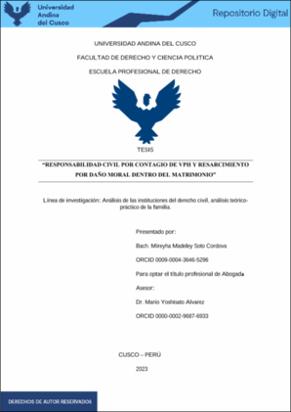| dc.contributor.advisor | Yoshisato Álvarez, Mario | |
| dc.contributor.author | Soto Cordova, Mireyha Madeley | |
| dc.date.accessioned | 2023-11-07T21:43:50Z | |
| dc.date.available | 2023-11-07T21:43:50Z | |
| dc.date.issued | 2023-07-01 | |
| dc.identifier.uri | https://hdl.handle.net/20.500.12557/5805 | |
| dc.description.abstract | La responsabilidad civil, en cualquiera de sus variantes (patrimonial y extrapatrimonial) es una
institución jurídica que ha merecido los más candentes de los debates, no solo por la doctrina
especializada, sino cuando se trata de resolver un caso particular a nivel de la judicatura. Esto
en razón a que el criterio de especialidad que se aplica en esta institución es sumamente
delicado, ya que se tocan aspectos muy vinculados a la vida diaria del ser humano, y que tienen
como responsabilidad salvaguardar bienes jurídicos protegidos tanto a nivel patrimonial como
extrapatrimonial.
El Perú no ha sido ajeno a este debate o situaciones, pues a lo largo de la vigencia del actual
código civil, se han producido situaciones que han sido objeto de críticas furibundas al respecto,
y en otros casos de análisis arteros que buscaban mejorar los criterios que en nuestra norma se
fijan.
Por lo mismo, y dado el tema de investigación que nos convoca, nos preguntamos ¿Qué sucede
cuando los criterios de especialidad no tienen que ver con aspectos estructurales de la propia
institución jurídica? Y por el contrario tienen que ver con un aspecto exógeno como la situación
a evaluar o la situación que debe ser sometido a juicio de responsabilidad. En este caso, las
cosas se agravan, pues como se ha mencionado, si bien de por si la institución de la
responsabilidad civil es compleja de por sí, el hecho de no tener especialización en diversos
temas lo agrava aún más.
Y ese es el caso de la responsabilidad ocasionada como consecuencia del contagio del Virus
del Papiloma Humano por parte de uno de los cónyuges en el otro, donde no solo entran a tallar
aspectos jurídicos, sino, como se verán en los resultados, aspectos de índole social y
psicológico. Por lo mismo, es importante que al presente trabajo se le dé una mirada detallada,
a fin de no caer en el excesivo pragmatismo jurídico o también conocida como miopía jurídica,
ya que en definitiva se deben considerar diversos aspectos que se complementan. | es_PE |
| dc.description.abstract | Civil liability, in any of its variants (patrimonial and extra patrimonial) is a legal institution that
has deserved the hottest of debates, not only due to specialized doctrine, but also when it comes
to resolving a particular case at the judiciary level. This is due to the fact that the specialty
criterion applied in this institution is extremely delicate, since aspects closely linked to the daily
life of the human being are touched, and whose responsibility is to safeguard protected legal
rights both at the patrimonial and non-patrimonial level.
Peru has not been oblivious to this debate or situations, since throughout the validity of the
current civil code, there have been situations that have been the subject of furious criticism in
this regard, and in other cases of devious analysis that sought to improve the criteria which are
set in our standard.
For the same reason, and given the research topic that summons us, we ask ourselves: What
happens when the specialty criteria do not have to do with structural aspects of the legal
institution itself? And on the contrary, they have to do with an exogenous aspect such as the
situation to be evaluated or the situation that must be subjected to a judgment of responsibility.
In this case, things get worse, because as mentioned, although the institution of civil liability is
complex in itself, the fact of not having specialization in various topics aggravates it even more.
And that is the case of the responsibility caused as a consequence of the contagion of the Human
Papilloma Virus by one of the spouses in the other, where not only legal aspects come into play,
but, as will be seen in the results, aspects of a nature social and psychological. For this reason,
it is important that this work be given a detailed look, in order not to fall into excessive legal
pragmatism or also known as legal myopia, since ultimately various aspects that complement
each other come into play here. | en_US |
| dc.format | application/pdf | es_PE |
| dc.language.iso | spa | es_PE |
| dc.publisher | Universidad Andina del Cusco | es_PE |
| dc.rights | info:eu-repo/semantics/openAccess | es_PE |
| dc.rights.uri | https://creativecommons.org/licenses/by-nc-nd/4.0/ | es_PE |
| dc.subject | Virus del Papiloma Humano | es_PE |
| dc.subject | Responsabilidad civil extracontractual | es_PE |
| dc.subject | Responsabilidad | es_PE |
| dc.title | Responsabilidad civil por contagio de VPH y resarcimiento por daño moral dentro del matrimonio | es_PE |
| dc.type | info:eu-repo/semantics/bachelorThesis | es_PE |
| thesis.degree.name | Abogada | es_PE |
| thesis.degree.grantor | Universidad Andina del Cusco. Facultad de Derecho y Ciencia Política | es_PE |
| thesis.degree.discipline | Derecho | es_PE |
| dc.publisher.country | PE | es_PE |
| dc.subject.ocde | https://purl.org/pe-repo/ocde/ford#5.05.00 | es_PE |
| renati.advisor.dni | 23845777 | |
| renati.advisor.orcid | https://orcid.org/0000-0002-9687-6933 | es_PE |
| renati.author.dni | 73958167 | |
| renati.discipline | 421016 | es_PE |
| renati.juror | Delgado Otazú, Ericson | |
| renati.juror | Ortiz Diaz, Renzo Guillermo | |
| renati.juror | Jayo Silva, Carlos Eduardo | |
| renati.juror | Alvarez Trujillo, Maria Antonieta | |
| renati.level | https://purl.org/pe-repo/renati/level#tituloProfesional | es_PE |
| renati.type | https://purl.org/pe-repo/renati/type#tesis | es_PE |
| dc.description.lineadeinvestigacion | Análisis de las instituciones del derecho civil, análisis teórico-práctico de la familia | es_PE |




